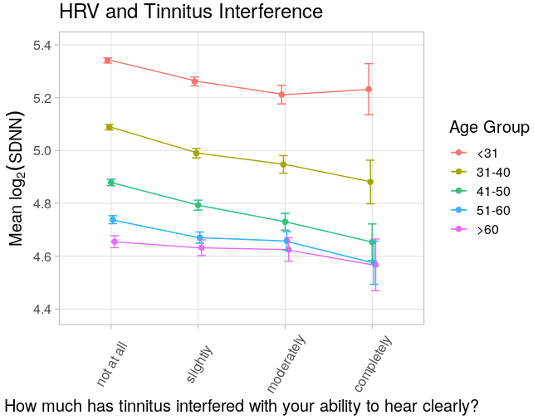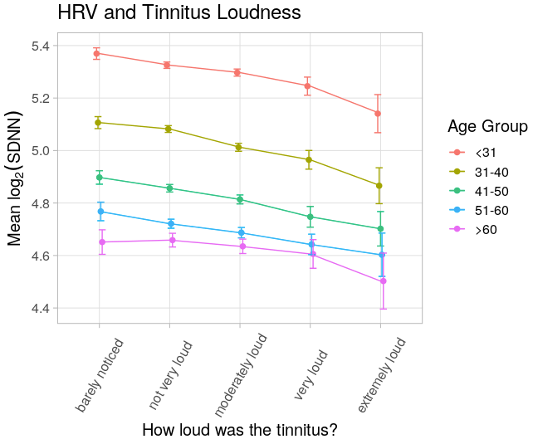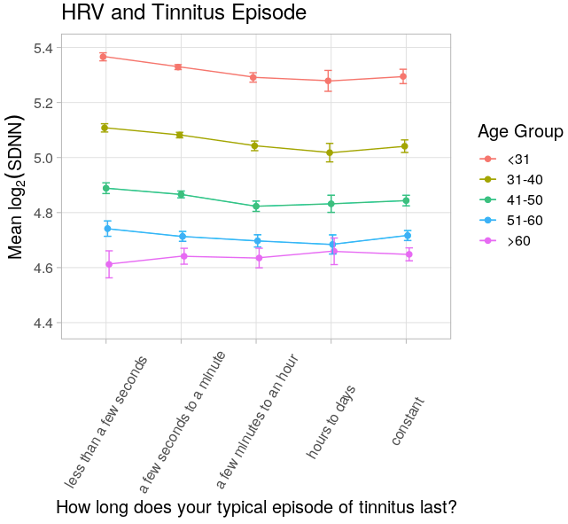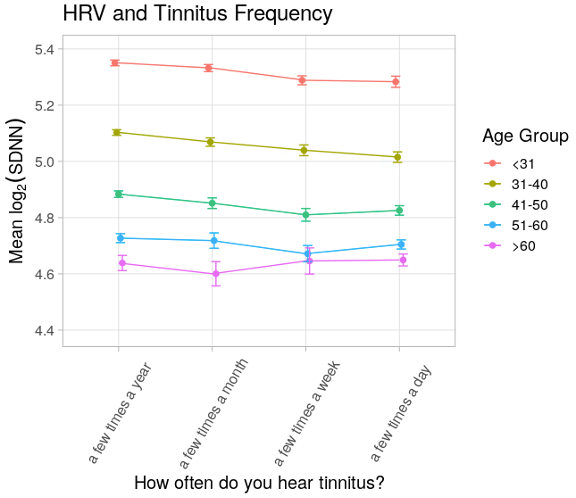Apple Hearing Study Identifies Connection Between Tinnitus and Heart Rate Variability in Adults
July 2nd, 2025 - Apple Hearing Study Team
The Apple Hearing Study
The Apple Hearing Study, a collaboration between the University of Michigan and Apple, aims to understand how sound exposure affects hearing health. In 2024 we found that about 15% of the participants in this Study of over 160,000 adults who provided informed consent to participate in this Study experienced tinnitus daily. Tinnitus is when a person hears a sound, often described as a ringing or buzzing, in one or both ears that is not coming from an external source. Tinnitus can be distressing and bothersome and can affect sleep, concentration, and overall mood.
For many individuals, the exact cause of tinnitus is unknown, but factors such as hearing loss, noise trauma, stress, among others, can contribute to an individual experiencing tinnitus (1). In our 2024 analysis of the Apple Hearing Study, we found that after noise trauma, stress was the second most common factor that users attributed as being the cause of their tinnitus. For some people with tinnitus, it is believed that stress can contribute to tinnitus which may in turn then cause additional stress and a self-perpetuating cycle of tinnitus and stress. Understanding how stress is connected to tinnitus may allow individuals, therapists, clinicians, and other healthcare practitioners to find better ways to help individuals cope with tinnitus.
What We Did
We wanted to see if an individual’s tinnitus severity (self-reported interference with hearing, loudness, duration, frequency) was associated with lower Heart Rate Variability (HRV) which can be an objective indicator of whether an individual is under stress (2, 3). While HRV is also influenced by fitness level, sleep, and other factors that may limit its interpretation at the individual level, on the population level HRV data can provide valuable insights into how stress may be related to tinnitus. As such, we analyzed data from 72,229 individuals in the Apple Hearing Study who answered questions about tinnitus and wore an Apple Watch in the period between September 28, 2020 to March 1, 2025. We used HRV data gathered on Apple Watch from 30 days before a participant took the tinnitus survey until 30 days after. HRV data on Apple Watch are automatically collected over a 1 minute period roughly 6 times daily and summarized as the standard deviation between normal to normal heartbeats (SDNN). Lower variability in the time between a person’s heartbeats (lower HRV) generally indicates less healthy interactions between the nervous system and the heart. We used HRV data during typical waking hours between 8am-9pm local time and that were averaged over a minimum of 7 days. After grouping subjects according to age, we compared participants’ average log-transformed SDNN between different tinnitus severity groups determined from the survey responses (Figures 1-4; error bars in the figures represent 95% confidence intervals around the mean).
What We Found
On average, we found that HRV was generally lower when participants reported that tinnitus interfered more with hearing (Figure 1), sounded louder (Figure 2), lasted longer (Figure 3), or occurred more frequently (Figure 4). The association between higher measures of tinnitus severity and lower HRV remained consistent after accounting for other factors including age, sex, and body mass index (BMI).
FIGURE 1

FIGURE 2

FIGURE 3

FIGURE 4

The Bottom Line
We believe that this is the largest study to date to show that HRV, as a potential physiological indicator of stress, is associated with tinnitus. We encourage people who have tinnitus to monitor and protect their ears from noise exposure and to consider interventions that could help reduce both tinnitus and stress.
Learn more about our methodology
HRV measures the variation in the time between an individual’s heartbeats and is tracked automatically throughout the day by Apple Watch. HRV data on Apple Watch are automatically collected over a 1 minute period roughly 6 times daily and summarized as the standard deviation between normal to normal heartbeats (SDNN). Greater variability in the time between a person’s heartbeats (higher HRV) generally indicates healthier interactions between the nervous system and the heart. This is because a person’s heart rate is controlled by the balance between the sympathetic and parasympathetic parts of the nervous system. While the sympathetic nervous system speeds up our heart rate and allows us to adapt to certain situations, the parasympathetic nervous system slows down our heart rate. In general, greater HRV reflects a healthier balance between these parts of the nervous system. Acute factors such as a hard workout or a bad night’s sleep can lead to a short-term lowering in HRV while more persistent factors such as chronic stress (2, 3), aging (5), and reduced fitness (6) can lead to longer term change in the balance between these parts of the nervous system and reduced HRV.
References:
- Berthold Langguth, Peter M Kreuzer, Tobias Kleinjung, Dirk De Ridder. 2013. “Tinnitus: causes and clinical management.” Neurology, volume 12, issue 9 (September): 920-930. https://doi.org/10.1016/S1474-4422(13)70160-1
- Julian F. Thayer, Fredrik Åhs, Mats Fredrikson, John J. Sollers, Tor D. Wager. 2012. “A meta-analysis of heart rate variability and neuroimaging studies: Implications for heart rate variability as a marker of stress and health.” Neuroscience & Biobehavioral Reviews, volume 36, Issue 2: (747-756), https://doi.org/10.1016/j.neubiorev.2011.11.009.
- Hye-Geum Kim, Eun-Jin Cheon, Dai-Seg Bai, Young Hwan Lee, Bon-Hoon Koo. 2018. “Stress and heart rate variability: A meta-analysis and review of the literature.” Pscychiatry Investigation, volume 15, issue 3 (February): 235-245. https://doi.org/10.30773/pi.2017.08.17
- Apple Inc. “Using Apple Watch to measure heart rate, calirometry, and activity.” November 2024. apple.com/health/pdf/Heart_Rate_Calorimetry_Activity_on_Apple_Watch_November_2024.pdf
- Fabiola Olivieri, Leonardo Biscetti, Lorenzo Pimpini, Guizeppe Pelliccioni, Jacopo Sabbatinelli, Sergio Giunta. 2024. “Heart rate variability and autonomic nervous system imbalance: potential biomarkers and detectable hallmarks of aging and inflaming.” Ageing Research Reviews, no 101 (November). https://doi.org/10.1016/j.arr.2024.102521
- Hugo Celso Dutra Souza, Stella Vieira Philbois, Ana Catarine Veiga, Bruno Augusto Aguilar. 2021. “Heart rate variability and cardiovascular fitness: what we know so far.” Vascular Health Risk Management. No 17 (November): 701-711. https://doi.org/10.2147/VHRM.S279322
